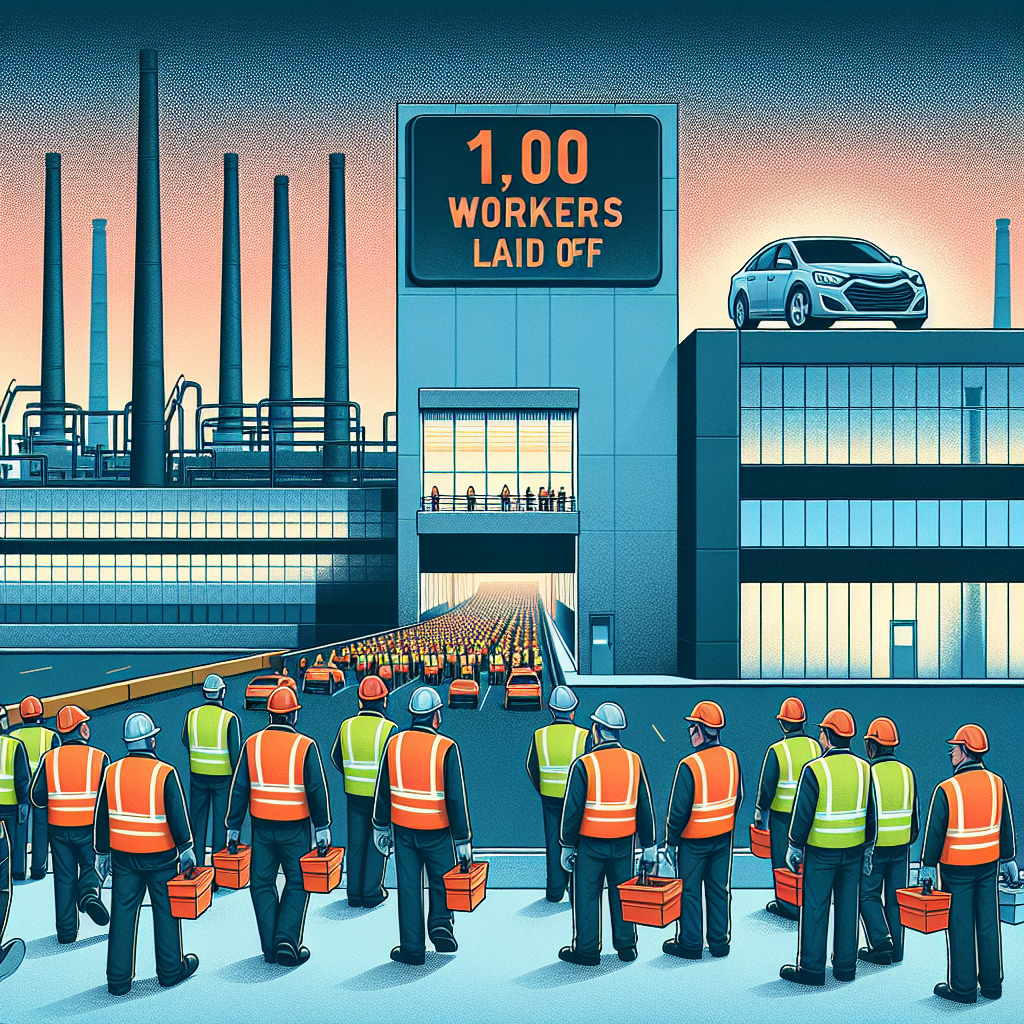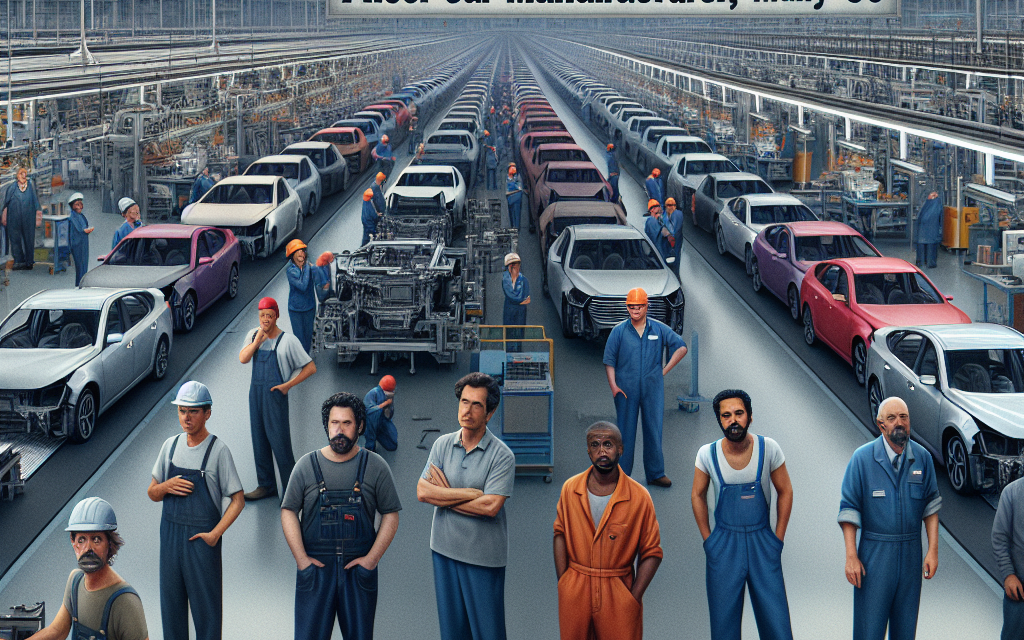“GM Cuts Jobs: Navigating Challenges in the Automotive Industry”
Introduction
General Motors (GM) is reportedly planning to lay off nearly 1,000 workers, with the majority of these job cuts occurring in the United States, according to sources familiar with the matter. This decision comes as part of the company’s ongoing efforts to streamline operations and reduce costs amid a challenging economic environment and evolving automotive industry landscape. The layoffs are expected to impact various departments within the organization, reflecting GM’s strategic shift towards more efficient and sustainable business practices. As the company navigates these changes, it continues to focus on its long-term goals of innovation and leadership in electric and autonomous vehicle technologies.
Impact Of GM Layoffs On The US Economy
The recent announcement by General Motors (GM) to lay off nearly 1,000 workers, primarily in the United States, has sparked significant concern regarding its potential impact on the broader US economy. As one of the largest automotive manufacturers in the world, GM’s decision is not just a reflection of its internal restructuring but also indicative of broader economic trends that could have far-reaching consequences. The layoffs, while directly affecting the employees and their families, also have a ripple effect that extends to various sectors of the economy.
To begin with, the immediate impact of these layoffs is felt most acutely by the workers who are losing their jobs. The loss of employment can lead to financial instability for these individuals and their families, affecting their ability to meet daily expenses and long-term financial commitments. This, in turn, can lead to decreased consumer spending, which is a critical driver of economic growth. When consumer spending declines, businesses across various sectors, from retail to services, may experience reduced revenues, potentially leading to further job cuts and a slowdown in economic activity.
Moreover, the layoffs at GM could have a significant impact on the communities where these workers reside. Many of these communities are heavily reliant on the automotive industry for employment and economic stability. The loss of nearly 1,000 jobs can lead to decreased local spending, affecting small businesses and service providers that depend on the patronage of GM employees. This can result in a contraction of the local economy, with potential declines in property values and tax revenues, which are essential for funding public services such as education and infrastructure.
In addition to the direct impact on workers and communities, the layoffs at GM may also have broader implications for the US manufacturing sector. The automotive industry is a key component of the manufacturing sector, and any significant changes within it can have a cascading effect on related industries, such as parts suppliers and logistics providers. These industries may face reduced demand for their products and services, leading to potential job losses and further economic challenges.
Furthermore, the decision by GM to lay off workers may also reflect broader trends in the global automotive industry, such as the shift towards electric vehicles and automation. As the industry undergoes significant transformation, companies are increasingly focusing on new technologies and business models, which may require a different skill set than traditional automotive manufacturing. This transition could lead to a mismatch between the skills of the current workforce and the needs of the industry, necessitating retraining and upskilling initiatives to ensure that workers can adapt to the changing landscape.
In conclusion, while the immediate impact of GM’s decision to lay off nearly 1,000 workers is felt by the affected employees and their communities, the broader implications for the US economy are significant. The potential decrease in consumer spending, the impact on local economies, and the challenges facing the manufacturing sector all highlight the interconnectedness of the economy and the importance of addressing these issues proactively. As the automotive industry continues to evolve, it is crucial for policymakers, businesses, and communities to work together to mitigate the negative impacts of such layoffs and to support the transition towards a more sustainable and resilient economic future.
Strategies For GM Workers Facing Layoffs
In light of recent reports indicating that General Motors (GM) plans to lay off nearly 1,000 workers, primarily in the United States, it is crucial for affected employees to consider strategic approaches to navigate this challenging period. The automotive industry, like many others, is subject to fluctuations driven by economic conditions, technological advancements, and shifts in consumer preferences. Consequently, workers facing layoffs must adopt proactive strategies to mitigate the impact on their professional and personal lives.
First and foremost, it is essential for employees to thoroughly understand their severance packages and any benefits they may be entitled to. This includes reviewing details about severance pay, health insurance continuation, and any outplacement services offered by GM. By having a clear understanding of these benefits, workers can better plan their financial future and make informed decisions about their next steps.
In addition to understanding severance packages, workers should prioritize updating their resumes and LinkedIn profiles to reflect their most recent experiences and accomplishments. This is a critical step in preparing for the job search process. Highlighting skills that are transferable to other industries can broaden employment opportunities. For instance, expertise in project management, quality control, or supply chain logistics can be valuable in various sectors beyond automotive manufacturing.
Networking is another vital strategy for those facing layoffs. Engaging with former colleagues, industry contacts, and professional associations can open doors to new opportunities. Attending industry conferences, workshops, and seminars can also provide valuable insights into emerging trends and potential job openings. Moreover, leveraging social media platforms to connect with professionals in related fields can expand one’s network and increase visibility to potential employers.
While seeking new employment, it may be beneficial for workers to consider further education or training to enhance their skill sets. Many community colleges and online platforms offer courses in high-demand areas such as information technology, data analysis, and renewable energy. By acquiring new skills, workers can position themselves competitively in the job market and potentially transition into growing industries.
Financial planning is another critical aspect for those facing layoffs. Creating a budget that accounts for reduced income and prioritizing essential expenses can help manage financial stress. Consulting with a financial advisor may also provide valuable guidance on managing savings, investments, and retirement accounts during this transitional period.
Moreover, maintaining a positive mindset is crucial for navigating the emotional challenges associated with job loss. Engaging in activities that promote mental and physical well-being, such as exercise, meditation, or hobbies, can help alleviate stress and maintain motivation. Seeking support from family, friends, or professional counselors can also provide emotional stability and encouragement.
In conclusion, while the prospect of layoffs can be daunting, adopting a strategic approach can empower GM workers to navigate this transition effectively. By understanding their benefits, updating professional profiles, networking, pursuing further education, planning finances, and maintaining a positive outlook, employees can position themselves for future success. As the job market continues to evolve, these strategies will not only aid in overcoming immediate challenges but also in building a resilient and adaptable career path.
The Future Of The Automotive Industry Amid GM Layoffs
The automotive industry is undergoing a significant transformation, driven by technological advancements, shifting consumer preferences, and the global push towards sustainability. In this context, General Motors’ recent decision to lay off nearly 1,000 workers, primarily in the United States, underscores the challenges and opportunities facing the sector. This development, while concerning for those directly affected, also highlights broader trends that are reshaping the future of automotive manufacturing and employment.
To begin with, the layoffs at General Motors can be seen as part of a larger strategy to realign resources and focus on emerging technologies. As the industry pivots towards electric vehicles (EVs) and autonomous driving, traditional manufacturing roles are being re-evaluated. Companies like GM are investing heavily in research and development to stay competitive in this rapidly evolving landscape. Consequently, the workforce is being restructured to prioritize skills that align with these new technological demands. This shift is not unique to GM; it reflects a broader industry trend where the emphasis is increasingly on innovation and sustainability.
Moreover, the transition to electric vehicles is a critical factor influencing employment patterns in the automotive sector. As governments worldwide implement stricter emissions regulations and offer incentives for EV adoption, automakers are compelled to accelerate their electrification plans. This shift necessitates a different set of skills, particularly in areas such as battery technology, software development, and systems integration. While this transition may lead to job displacement in traditional manufacturing roles, it also creates opportunities for new employment in these emerging fields. Therefore, the challenge for both companies and workers is to adapt to these changes through reskilling and upskilling initiatives.
In addition to technological advancements, the automotive industry is also grappling with supply chain disruptions and economic uncertainties. The COVID-19 pandemic exposed vulnerabilities in global supply chains, leading to shortages of critical components such as semiconductors. These disruptions have forced automakers to reassess their supply chain strategies, often resulting in production slowdowns and workforce adjustments. The layoffs at GM may, in part, be a response to these ongoing challenges, as the company seeks to optimize its operations in a volatile market environment.
Furthermore, consumer preferences are evolving, with an increasing demand for connected and personalized mobility solutions. This shift is driving automakers to explore new business models, such as mobility-as-a-service and subscription-based offerings. As a result, the industry is witnessing a convergence of automotive and technology sectors, leading to collaborations and partnerships that are reshaping the competitive landscape. For workers, this means that adaptability and a willingness to embrace new technologies are becoming essential attributes in the modern automotive workforce.
In conclusion, the layoffs at General Motors serve as a microcosm of the broader changes occurring within the automotive industry. While the immediate impact on affected workers is undoubtedly challenging, these developments also signal a period of transformation and opportunity. As the industry continues to evolve, driven by technological innovation and changing consumer demands, the focus will increasingly be on building a workforce equipped to navigate this new era. By investing in education and training, both companies and employees can position themselves to thrive in the future of automotive manufacturing. Ultimately, the ability to adapt to these changes will determine the industry’s success in the years to come.
Analyzing GM’s Decision To Lay Off Nearly 1,000 Workers

General Motors (GM), one of the leading automotive manufacturers globally, has recently announced its decision to lay off nearly 1,000 workers, primarily in the United States. This move has sparked considerable discussion and analysis within the industry, as stakeholders seek to understand the underlying reasons and potential implications of such a significant workforce reduction. The decision comes at a time when the automotive industry is undergoing substantial transformation, driven by technological advancements, shifting consumer preferences, and the ongoing transition towards electric vehicles (EVs).
To begin with, it is essential to consider the broader context in which GM’s decision is situated. The automotive industry is currently facing a period of unprecedented change, with companies investing heavily in the development of EVs and autonomous vehicles. This shift is largely driven by increasing regulatory pressures to reduce carbon emissions and the growing demand for sustainable transportation solutions. Consequently, traditional automakers like GM are compelled to reallocate resources and restructure their operations to remain competitive in this evolving landscape.
In light of these industry-wide changes, GM’s decision to lay off workers can be seen as part of a strategic effort to streamline operations and optimize efficiency. By reducing its workforce, the company aims to cut costs and redirect investments towards areas that are critical for future growth, such as EV technology and digital innovation. This approach is not unique to GM; many other automakers are similarly restructuring their operations to align with the demands of the modern automotive market.
Moreover, it is important to recognize that the layoffs are primarily concentrated in the United States, a region that has traditionally been a stronghold for GM. This geographic focus may be indicative of the company’s intention to consolidate its operations in key markets while exploring opportunities for expansion in emerging regions. Additionally, the decision may reflect the need to address specific challenges within the U.S. market, such as fluctuating demand for certain vehicle models and the impact of supply chain disruptions.
While the layoffs are undoubtedly a difficult decision for GM and a challenging development for the affected employees, it is crucial to consider the potential long-term benefits of such a move. By realigning its workforce and resources, GM is positioning itself to better navigate the complexities of the modern automotive industry. This strategic realignment could ultimately enhance the company’s ability to innovate and compete in the rapidly evolving market for EVs and advanced automotive technologies.
Furthermore, GM’s decision underscores the importance of adaptability and resilience in the face of industry transformation. As the automotive sector continues to evolve, companies must be willing to make difficult decisions and embrace change to ensure their long-term viability. This includes not only investing in new technologies but also reevaluating traditional business models and operational structures.
In conclusion, GM’s decision to lay off nearly 1,000 workers, primarily in the United States, is a reflection of the broader changes occurring within the automotive industry. While the move presents immediate challenges for the affected employees, it also represents a strategic effort by GM to position itself for future success in a rapidly changing market. As the company continues to navigate this period of transformation, its ability to adapt and innovate will be critical in maintaining its competitive edge and securing its place in the automotive landscape of the future.
How GM Layoffs Reflect Broader Trends In The Auto Sector
General Motors (GM), one of the largest automobile manufacturers in the world, is reportedly planning to lay off nearly 1,000 workers, primarily in the United States. This decision, while significant in its immediate impact on the affected employees, also serves as a reflection of broader trends currently shaping the auto sector. The automotive industry is undergoing a transformative period, driven by technological advancements, shifts in consumer preferences, and global economic pressures. These factors collectively contribute to the strategic decisions made by major players like GM.
To begin with, the automotive industry is increasingly pivoting towards electric vehicles (EVs) as part of a global push for sustainability and reduced carbon emissions. This shift necessitates a reallocation of resources and a reevaluation of workforce needs. Traditional internal combustion engine (ICE) vehicles require different manufacturing processes and skill sets compared to EVs. Consequently, companies like GM are compelled to restructure their operations to align with this new direction. The layoffs, therefore, may be part of a broader strategy to streamline operations and invest more heavily in EV technology and infrastructure.
Moreover, the rise of automation and advanced manufacturing technologies is reshaping the labor landscape within the auto sector. Automation offers increased efficiency and cost-effectiveness, but it also reduces the need for certain manual labor roles. As GM and other automakers integrate more automated processes into their production lines, the demand for specific job functions diminishes. This technological evolution, while beneficial for long-term productivity, poses challenges for workers whose roles are rendered obsolete or redundant.
In addition to technological shifts, the global economic environment exerts considerable influence on the auto industry. Supply chain disruptions, fluctuating raw material costs, and geopolitical tensions contribute to an unpredictable market landscape. Automakers must navigate these challenges while maintaining profitability and competitiveness. In such a context, workforce adjustments, including layoffs, become a tool for companies to manage costs and adapt to changing market conditions.
Furthermore, consumer preferences are evolving, with an increasing emphasis on connectivity, autonomous driving features, and personalized vehicle experiences. Automakers are investing heavily in research and development to meet these demands, which often requires reallocating resources from other areas. The focus on innovation and new product development can lead to workforce restructuring as companies seek to align their human resources with strategic priorities.
It is also important to consider the impact of regional market dynamics. While GM’s layoffs are primarily concentrated in the United States, the decision may be influenced by varying demand patterns across different markets. For instance, emerging markets may present growth opportunities that necessitate a shift in focus and resources. Conversely, mature markets might experience slower growth, prompting companies to optimize their operations accordingly.
In conclusion, GM’s decision to lay off nearly 1,000 workers is emblematic of broader trends within the auto sector. The industry’s transition towards electric vehicles, the integration of automation, economic pressures, evolving consumer preferences, and regional market dynamics all play a role in shaping such strategic decisions. While the immediate impact on affected employees is significant, these layoffs are part of a larger narrative of transformation and adaptation within the automotive industry. As companies like GM navigate this complex landscape, they must balance the need for innovation and efficiency with the challenges of workforce management and social responsibility.
Support Systems For Employees Affected By GM Layoffs
The recent announcement that General Motors (GM) plans to lay off nearly 1,000 workers, primarily in the United States, has sent ripples of concern through the automotive industry and the communities that depend on it. As these employees face the uncertainty of job loss, it becomes imperative to explore the support systems available to them during this challenging transition. Understanding the resources and assistance programs can help mitigate the impact of such layoffs and provide a pathway to new opportunities.
First and foremost, government programs play a crucial role in supporting displaced workers. Unemployment benefits, administered at the state level, offer temporary financial assistance to those who have lost their jobs through no fault of their own. These benefits can help bridge the gap between employment, providing a safety net while individuals seek new opportunities. Additionally, the federal government offers programs such as the Trade Adjustment Assistance (TAA), which specifically aids workers who have lost their jobs due to foreign competition. This program provides training, job search assistance, and relocation allowances, helping workers transition to new industries or roles.
Moreover, GM itself may offer severance packages to affected employees. These packages often include a lump-sum payment based on years of service, continued health benefits for a limited period, and outplacement services. Outplacement services are particularly valuable as they provide career counseling, resume writing assistance, and job search support, equipping employees with the tools needed to navigate the job market effectively. By offering these resources, GM can demonstrate a commitment to its workforce, even in times of downsizing.
In addition to company and government support, community organizations and non-profits can be instrumental in assisting laid-off workers. Local workforce development agencies often collaborate with businesses and educational institutions to provide training programs tailored to the needs of the local job market. These programs can help workers acquire new skills or certifications, making them more competitive candidates for emerging job opportunities. Furthermore, non-profit organizations may offer financial counseling, mental health support, and networking events, fostering a sense of community and resilience among those affected.
Networking and professional associations also play a vital role in supporting displaced workers. Engaging with industry-specific groups can provide valuable connections and insights into job openings that may not be widely advertised. Additionally, these associations often host workshops and seminars that focus on skill development and industry trends, keeping members informed and prepared for new opportunities. By actively participating in these networks, laid-off workers can expand their professional circles and increase their chances of finding suitable employment.
Finally, it is essential for affected employees to take proactive steps in managing their career transitions. This includes updating resumes and LinkedIn profiles, reaching out to former colleagues for potential job leads, and considering further education or training to enhance their skill sets. By taking charge of their career paths, individuals can turn a challenging situation into an opportunity for growth and development.
In conclusion, while the news of GM’s layoffs is undoubtedly distressing for the nearly 1,000 workers affected, a variety of support systems are available to help them navigate this difficult period. From government programs and company-provided resources to community organizations and professional networks, these support systems can provide the necessary assistance and guidance. By leveraging these resources and taking proactive steps, displaced workers can find new opportunities and continue to thrive in their careers.
The Role Of Automation In GM’s Workforce Reduction
General Motors (GM), a stalwart in the automotive industry, is reportedly planning to lay off nearly 1,000 workers, with the majority of these job cuts occurring in the United States. This decision, while influenced by various factors, underscores the growing role of automation in reshaping the workforce landscape. As technology continues to advance at a rapid pace, companies like GM are increasingly integrating automated systems into their operations, leading to significant changes in employment dynamics.
The automotive industry has long been at the forefront of technological innovation, and GM is no exception. Over the years, the company has invested heavily in automation to enhance efficiency, reduce costs, and maintain competitiveness in a rapidly evolving market. Automation, with its promise of increased productivity and precision, has become an indispensable tool for manufacturers. However, this shift towards automated processes inevitably impacts the human workforce, as machines and software take over tasks traditionally performed by people.
In the context of GM’s recent workforce reduction, automation plays a pivotal role. The integration of robotics and advanced manufacturing technologies allows the company to streamline production processes, minimize errors, and accelerate output. Consequently, the need for manual labor in certain areas diminishes, leading to a reevaluation of workforce requirements. While automation brings undeniable benefits to production efficiency, it also presents challenges in terms of employment, as workers find themselves displaced by machines capable of performing repetitive tasks with greater speed and accuracy.
Moreover, the transition to electric vehicles (EVs) further amplifies the impact of automation on GM’s workforce. As the company shifts its focus towards EV production, the manufacturing processes involved differ significantly from those of traditional internal combustion engine vehicles. Electric vehicles require fewer parts and less complex assembly processes, which can be more easily automated. This shift not only necessitates a different skill set among workers but also reduces the overall demand for labor in certain segments of the production line.
In addition to the technological advancements driving automation, economic factors also play a crucial role in GM’s decision to reduce its workforce. The automotive industry is subject to fluctuating market conditions, including changes in consumer preferences, regulatory pressures, and global economic trends. In response to these challenges, companies like GM must continually adapt their strategies to remain viable. Automation offers a means to achieve cost savings and operational efficiencies, enabling GM to navigate economic uncertainties more effectively.
While the benefits of automation are clear, it is essential to consider the broader implications for the workforce. The displacement of workers due to automation necessitates a proactive approach to workforce development and retraining. As GM and other companies embrace automation, there is a growing need for initiatives that equip workers with the skills required for new roles in an increasingly automated environment. This includes investing in education and training programs that focus on emerging technologies and fostering a culture of continuous learning.
In conclusion, GM’s decision to lay off nearly 1,000 workers highlights the significant role of automation in shaping the future of the automotive industry. As the company continues to integrate advanced technologies into its operations, the impact on the workforce is inevitable. While automation offers numerous advantages in terms of efficiency and cost-effectiveness, it also presents challenges that must be addressed through strategic workforce planning and development. By embracing these changes and investing in the skills of their employees, companies like GM can navigate the complexities of automation while ensuring a sustainable future for their workforce.
Q&A
1. **What is the reason for GM’s decision to lay off nearly 1,000 workers?**
GM is likely restructuring to cut costs and improve efficiency in response to changing market conditions and economic pressures.
2. **Which regions are primarily affected by these layoffs?**
The layoffs are primarily affecting workers in the United States.
3. **What sectors within GM are most impacted by these layoffs?**
The specific sectors have not been detailed, but layoffs often impact administrative, manufacturing, or non-core business areas.
4. **How has GM communicated this decision to its employees?**
GM typically communicates such decisions through internal memos, meetings, or direct notifications to the affected employees.
5. **What is the expected timeline for these layoffs to take place?**
The timeline for layoffs can vary, but they are often implemented over several weeks or months following the announcement.
6. **How might these layoffs impact GM’s operations or production?**
While layoffs can streamline operations and reduce costs, they may also temporarily disrupt production or affect employee morale.
7. **What has been the public or market reaction to GM’s layoff announcement?**
Public and market reactions can vary, but such announcements often lead to scrutiny from media, investors, and labor groups, potentially affecting stock prices and company reputation.
Conclusion
General Motors’ decision to lay off nearly 1,000 workers, primarily in the United States, reflects ongoing challenges in the automotive industry, including shifts in consumer demand, technological advancements, and economic pressures. This move underscores the company’s need to adapt to changing market conditions and optimize its workforce for future growth and sustainability. However, it also highlights the broader impact on employees and communities, emphasizing the importance of strategic planning and support for those affected by such transitions.





